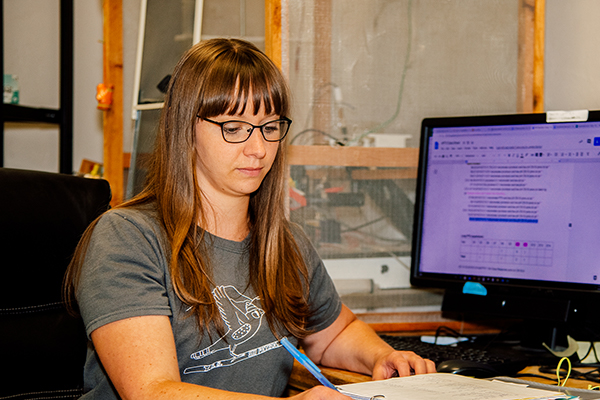Trouble with her own brainstem indirectly contributed to Idaho State University nontraditional student Jennie Nelson going on to study and do procedures on the brainstems of the embryos of birds as an undergraduate at ISU.
That experience of working on the bird embryos in ISU professor Jason Pilarski’s laboratory then helped Nelson land a spot in the University of Utah’s neuroscience doctoral program, which she will begin this August. For her doctoral work, she wants to study the embryonic development of the brain.
“I believe that if we can understand how the brain develops we can better understand how diseases develop and then we can find better treatments for them since we have more knowledge of the mechanisms behind them,” Nelson said.
She is one of the few, if not the only ISU student ever, to receive a prestigious Barry Goldwater Scholarship, which she was awarded for the 2019-20 academic year. She was one of 496 students nationwide out of an applicant pool of more than 5,000 to receive the scholarship the year she applied. The scholarship was worth $7,500 to her for the last year of her undergraduate career.
But none of this may have happened if Nelson, a native of Boise and Meridian, hadn’t had a neck problem right after she graduated from high school.
“I went to school right out of high school thinking I wanted an accounting degree and then I got these really bad headaches and I couldn’t continue college and it took me a few years to figure out what was wrong,” Nelson said. “I couldn’t work, couldn’t do anything, it was a complete disability.”

Jennie Nelson
She quit school and for years searched for an answer to her debilitating pain and when she finally found the answer to it, it turned out to be something simple. She had a “subluxation” – a partial abnormal separation – between here first and second vertebrae that was pinching her brain stem from the front and the back.
“I can’t even tell you how many doctors, different kinds I went to, but it was the fourth or fifth chiropractor I went to that was finally able to recognize the issue and then adjust me accordingly,” Nelson said. “It was a simple chiropractic adjustment that took care of it.”
She said it was coincidental that she had a problem with her brainstem and then studied Zebra Finch brainstems at ISU, but her injury did get her thinking about a career path in neuroscience.
“Seeing how that brainstem was pinched you just realized that among other things that the brain is the center hub of the body,” Nelson said. “It is pretty much where everything starts and ends, and there is so much we don’t know about it and that is why I decided to do neuroscience research because there are so many things I can learn. I want to know about what we don’t know about the brain. That is my goal.”
Nelson worked in doctors’ offices for about 7-1/2 -years before returning to school. Three years after getting her neck problem solved, Nelson tried an accounting course at the College of Western Idaho in Nampa in 2012, but realized she wasn’t interested in it. Then in 2015, at age 28, she re-enrolled in the CWI part time to study biology.
“It took me a while to figure out that research was what I wanted to do because I am insatiably curious, I get bored with everything I do and I love constantly learning and I love science,” she said. “So I decided to do research.”
In 2016 she transferred to ISU to attend school full time to pursue her dream, and 2-1/2 years ago she landed a spot in Pilarski’s laboratory where she has spent 20-25 hours a week working during the school year and 40-60 a week in the summer.
Pilarski’s lab, affectionately known as Team Bird Brain, maintains a National Institutes of Health-funded project that aims to understand the structure and function of brainstem rhythm-generating neural networks with particular emphasis on developing animals and breathing behaviors.
“The long-term goal of my research team is to understand how brainstem motor circuits that control life sustaining autonomous breathing patterns develop, mature and maintain rhythmic activity in the context of health and disease,” Pilarski said.
Among her duties in the lab, Nelson has been doing micro-procedures on the brainstems of Zebra Finch embryos, to make recordings of nerve signals and patterns over the course of incubation.
“First you have to be able to recognize the nerves, then you have to recognize good nerves and then you actually have to find them again and record those,” she said. “It is a pretty complex thing. You do it under a microscope. The smaller embryo brainstems are about the size of the end of a sharpened pencil, they are very tiny.”
Nelson said she has loved working in the lab where Pilarski is “an awesome mentor” and she credits her experience in the laboratory for helping her receive the Goldwater scholarship and in landing a competitive spot in the University of Utah doctoral Neuroscience Program.
“I felt like in college I have learned infinitely more by working in that lab than taking courses – not that I didn’t learn a lot in my courses – but I feel like being able to integrate that information in the lab allowed me to learn far beyond what I learned in class,” Nelson said. “It was amazing. I wish it was something everyone could do.”
